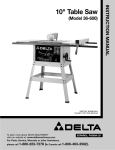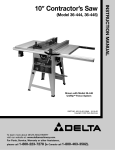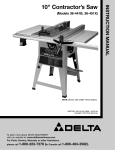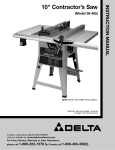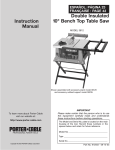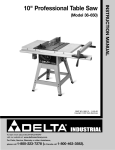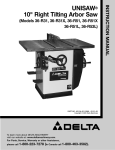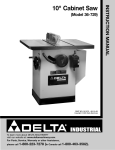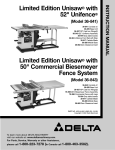Download Delta 36-325C Instruction manual
Transcript
10″ Table Saw (Model 36-325C) PART NO. 1235564 (014) Copyright © 2001 Delta Machinery To learn more about DELTA MACHINERY visit our website at: www.deltamachinery.com. For Parts, Service, Warranty or other Assistance, please call 1-800-GO-DELTA (463-3582). INSTRUCTION MANUAL Français au verso SAFETY RULES Woodworking can be dangerous if safe and proper operating procedures are not followed. As with all machinery, there are certain hazards involved with the operation of the product. Using the machine with respect and caution will considerably lessen the possibility of personal injury. However, if normal safety precautions are overlooked or ignored, personal injury to the operator may result. Safety equipment such as guards, push sticks, hold-downs, featherboards, goggles, dust masks and hearing protection can reduce your potential for injury. But even the best guard won’t make up for poor judgment, carelessness or inattention. Always use common sense and exercise caution in the workshop. If a procedure feels dangerous, don’t try it. Figure out an alternative procedure that feels safer. REMEMBER: Your personal safety is your responsibility. This machine was designed for certain applications only. Delta Machinery strongly recommends that this machine not be modified and/or used for any application other than that for which it was designed. If you have any questions relative to a particular application, DO NOT use the machine until you have first contacted Delta to determine if it can or should be performed on the product. Technical Service Manager Delta Machinery 4825 Highway 45 North Jackson, TN 38305 (IN CANADA: 505 SOUTHGATE DRIVE, GUELPH, ONTARIO N1H 6M7) WARNING: FAILURE TO FOLLOW THESE RULES MAY RESULT IN SERIOUS PERSONAL INJURY 1. FOR YOUR OWN SAFETY, READ INSTRUCTION MANUAL BEFORE OPERATING THE TOOL. Learn the tool’s application and limitations as well as the specific hazards peculiar to it. 2. KEEP GUARDS IN PLACE and in working order. 3. ALWAYS WEAR EYE PROTECTION. 4. REMOVE ADJUSTING KEYS AND WRENCHES. Form habit of checking to see that keys and adjusting wrenches are removed from tool before turning it “on”. 5. KEEP WORK AREA CLEAN. Cluttered areas and benches invite accidents. 6. DON’T USE IN DANGEROUS ENVIRONMENT. Don’t use power tools in damp or wet locations, or expose them to rain. Keep work area well-lighted. 7. KEEP CHILDREN AND VISITORS AWAY. All children and visitors should be kept a safe distance from work area. 8. MAKE WORKSHOP CHILDPROOF – with padlocks, master switches, or by removing starter keys. 9. DON’T FORCE TOOL. It will do the job better and be safer at the rate for which it was designed. 10. USE RIGHT TOOL. Don’t force tool or attachment to do a job for which it was not designed. 11. WEAR PROPER APPAREL. No loose clothing, gloves, neckties, rings, bracelets, or other jewelry to get caught in moving parts. Nonslip footwear is recommended. Wear protective hair covering to contain long hair. 12. ALWAYS USE SAFETY GLASSES. Wear safety glasses. Everyday eyeglasses only have impact resistant lenses; they are not safety glasses. Also use face or dust mask if cutting operation is dusty. These safety glasses must conform to ANSI Z87.1 requirements. Note: Approved glasses have Z87 printed or stamped on them. 13. SECURE WORK. Use clamps or a vise to hold work when practical. It’s safer than using your hand and frees both hands to operate tool. 14. DON’T OVERREACH. Keep proper footing and balance at all times. 15. MAINTAIN TOOLS IN TOP CONDITION. Keep tools sharp and clean for best and safest performance. Follow instructions for lubricating and changing accessories. 16. DISCONNECT TOOLS before servicing and when changing accessories such as blades, bits, cutters, etc. 17. USE RECOMMENDED ACCESSORIES. The use of accessories and attachments not recommended by Delta may cause hazards or risk of injury to persons. 2 18. R E D U C E T H E R I S K O F U N I N T E N T I O N A L STARTING. Make sure switch is in “OFF” position before plugging in power cord. In the event of a power failure, move switch to the “OFF” position. 19. NEVER STAND ON TOOL. Serious injury could occur if the tool is tipped or if the cutting tool is accidentally contacted. 20. CHECK DAMAGED PARTS. Before further use of the tool, a guard or other part that is damaged should be carefully checked to ensure that it will operate properly and perform its intended function – check for alignment of moving parts, binding of moving parts, breakage of parts, mounting, and any other conditions that may affect its operation. A guard or other part that is damaged should be properly repaired or replaced. 21. DIRECTION OF FEED. Feed work into a blade or cutter against the direction of rotation of the blade or cutter only. 22. NEVER LEAVE TOOL RUNNING UNATTENDED. TURN POWER OFF. Don’t leave tool until it comes to a complete stop. 23. DRUGS, ALCOHOL, MEDICATION. Do not operate tool while under the influence of drugs, alcohol or any medication. 24. MAKE SURE TOOL IS DISCONNECTED FROM P O W E R S U P P LY w h i l e m o t o r i s b e i n g m o u n t e d , connected or re-connected. 25. THE DUST GENERATED by certain woods and wood products can be injurious to your health. Always operate machinery in well ventilated areas and provide for proper dust removal. Use wood dust collection systems whenever possible. 26. WARNING: SOME DUST CREATED BY POWER SANDING, SAWING, GRINDING, DRILLING, AND OTHER CONSTRUCTION ACTIVITIES contains chemicals known to cause cancer, birth defects or other reproductive harm. Some examples of these chemicals are: • lead from lead-based paints, • crystalline silica from bricks and cement and other masonry products, and • arsenic and chromium from chemically-treated lumber. Your risk from these exposures varies, depending on how often you do this type of work. To reduce your exposure to these chemicals: work in a well ventilated area, and work with approved safety equipment, such as those dust masks that are specially designed to filter out microscopic particles. SAVE THESE INSTRUCTIONS. Refer to them often and use them to instruct others. ADDITIONAL SAFETY RULES FOR TABLE SAWS 1. DO NOT OPERATE YOUR TOOL until it is completely assembled and installed according to the instructions. 13. NEVER reach behind or over the cutting tool with either hand for any reason. 14. DIRECTION OF FEED. Feed work into cutting tool against the direction or rotation of the cutting tool only. 2. IF YOU ARE NOT thoroughly familiar with the operation of circular saws, obtain advice from your supervisor, instructor, or other qualified person. 15. DO NOT feed the material too fast while cutting. Feed the material only fast enough so that the blade will cut. 3. ALWAYS use guard, splitter and anti-kickback fingers on all “thru-sawing” operations. Thru-sawing operations are those when the blade cuts completely through the workpiece as in ripping or cross-cutting. 16. NEVER attempt to free a stalled saw blade without first turning the saw “OFF.” 4. ALWAYS hold the work firmly against the miter gage or fence. 17. NEVER start the saw with the workpiece pressed against the blade. 5. NEVER use the fence as a cut-off gage when crosscutting. 18. NEVER turn the saw “ON” before clearing the table of all objects (tools, scraps of wood, etc.). 6. MOVE the rip fence out of the way when crosscutting. 19. ALWAYS STOP the saw before removing scrap pieces from the table. 7. NEVER perform any operation “free-hand” which means using your hands to support or guide the workpiece. Always use either the fence or miter gage to position and guide the work. 20. NEVER perform layout, assembly or set-up work on the table while the saw is operating. 21. PROVIDE adequate support to the rear and sides of the saw table for wide or long workpieces. 8. ALWAYS use a push stick for ripping narrow stock. Refer to ripping applications in instruction manual where the push stick is covered in detail. 22. WHEN cutting mouldings, NEVER run the stock between the fence and the moulding cutterhead. 23. NEVER use solvents to clean plastic parts. Solvents could possibly dissolve or otherwise damage the material. Only a soft damp cloth should be used to clean plastic parts. 9. AVOID kickbacks (work thrown back toward you) by: A. Keeping blade sharp. B. Keeping rip fence parallel to the saw blade. 24. SHOULD any part of your tool be missing, damaged, or fail in any way, or any electrical components fail to perform properly, shut off tool and remove plug from power supply outlet. Replace missing, damaged or failed parts before resuming operation. C. Keeping splitter and anti-kickback fingers and guard in place and operating. D. Not releasing the work before it is pushed all the way past the saw blade. 25. IMPORTANT: When the tool is not in use, the switch should be locked in the “OFF” position to prevent unauthorized use. E. Not ripping work that is twisted or warped or does not have a straight edge to guide along the fence. 26. ADDITIONAL INFORMATION regarding the safe and proper operation of this product is available from the National Safety Council, 1121 Spring Lake Drive, Itasca, IL 60143-3201, in the Accident Prevention Manual for Industrial Operations and also in the Safety Data Sheets provided by the NSC. Please also refer to the American National Standards Institute ANSI 01.1 Safety Requirements for Woodworking Machinery and the U.S. Department of Labor OSHA 1910.213 Regulations. 10. AVOID awkward operations and hand positions where a sudden slip could cause your hand to move into the cutting tool. 11. ALWAYS keep hands and fingers away from the cutting tool. 12. NEVER stand or have any part of your body in line with the path of the saw blade. 3 CONNECTING TOOL TO POWER SOURCE POWER CONNECTIONS A separate electrical circuit should be used for your tools. This circuit should not be less than #12 wire and should be protected with a 20 Amp time lag fuse. If an extension cord is used, use only 3-wire extension cords which have 3prong grounding type plugs and 3-hole receptacles which accept the tool’s plug. Before connecting the motor to the power line, make sure the switch is in the “OFF” position and be sure that the electric current is of the same characteristics as indicated on the tool. All line connections should make good contact. Running on low voltage will damage the motor. MOTOR SPECIFICATIONS Your tool is wired for 120 volt, 60 HZ alternating current. Before connecting the tool to the power source, make sure the switch is in the “OFF” position. The no-load speed of the motor is 5500 RPM. GROUNDING INSTRUCTIONS WARNING: THIS TOOL MUST BE GROUNDED WHILE IN USE TO PROTECT THE OPERATOR FROM ELECTRIC SHOCK. 2. Grounded, cord-connected tools intended for use on a supply circuit having a nominal rating less than 150 volts: 1. All grounded, cord-connected tools: In the event of a malfunction or breakdown, grounding provides a path of least resistance for electric current to reduce the risk of electric shock. This tool is equipped with an electric cord having an equipment-grounding conductor and a grounding plug. The plug must be plugged into a matching outlet that is properly installed and grounded in accordance with all local codes and ordinances. This tool is intended for use on a circuit that has an outlet that looks like the one illustrated in Fig. AA. The tool has a grounding plug that looks like the plug illustrated in Fig. AA. A temporary adapter, which looks like the adapter illustrated in Fig. BB, may be used to connect this plug to a 2-hole receptacle as shown in Fig. BB if a properly grounded outlet is not available. The temporary adapter should be used only until a properly grounded outlet can be installed by a qualified electrician. The green-colored rigid ear, lug, and the like, extending from the adapter must be connected to a permanent ground such as a properly grounded outlet box. Whenever the adapter is used, it must be held in place with a metal screw. Do not modify the plug provided - if it will not fit the outlet, have the proper outlet installed by a qualified electrician. Improper connection of the equipment-grounding conductor can result in risk of electric shock. The conductor with insulation having an outer surface that is green with or without yellow stripes is the equipmentgrounding conductor. If repair or replacement of the electric cord or plug is necessary, do not connect the equipment-grounding conductor to a live terminal. NOTE: In Canada, the use of a temporary adapter is not permitted by the Canadian Electric Code. Check with a qualified electrician or service personnel if t h e g ro u n d i n g i n s t r u c t i o n s a re n o t c o m p l e t e l y understood, or if in doubt as to whether the tool is properly grounded. WARNING: IN ALL CASES, MAKE CERTAIN THE RECEPTACLE IN QUESTION IS PROPERLY G R O U N D E D . I F Y O U A R E N O T S U R E H AV E A QUALIFIED ELECTRICIAN CHECK THE RECEPTACLE. Use only 3-wire extension cords that have 3-prong grounding type plugs and 3-hole receptacles that accept the tool’s plug, as shown in Fig. AA. Repair or replace damaged or worn cord immediately. HOLES GROUNDED OUTLET BOX GROUNDED OUTLET BOX CURRENT CARRYING PRONGS GROUNDING MEANS ADAPTER GROUNDING BLADE IS LONGEST OF THE 3 BLADES HOLES Fig. AA Fig. BB 4 EXTENSION CORDS Use proper extension cords. Make sure your extension cord is in good condition and is a 3-wire extension cord which has a 3-prong grounding type plug and a 3-hole receptacle which will accept the tool’s plug. When using an extension cord, be sure to use one heavy enough to carry the current of the saw. An undersized cord will cause a drop in line voltage, resulting in loss of power and overheating. Fig. DD, shows the correct gauge to use depending on the cord length. If in doubt, use the next heavier gauge. The smaller the gauge number, the heavier the cord. MINIMUM GAUGE EXTENSION CORD MINIMUM GAUGE EXTENSION CORD RECOMMENDED SIZES FOR USE WITH STATIONARY ELECTRIC TOOLS RECOMMENDED SIZES FOR USE WITH STATIONARY ELECTRIC TOOLS Ampere Rating 0-6 0-6 0-6 0-6 6-10 6-10 6-10 6-10 10-12 10-12 10-12 10-12 12-16 12-16 12-16 Volts 120 120 120 120 120 120 120 120 120 120 120 120 120 120 120 Total Length of Cord in Feet up to 25 25-50 50-100 100-150 up to 25 25-50 50-100 100-150 up to 25 25-50 50-100 100-150 up to 25 25-50 Gauge of Extension Cord 18 AWG 16 AWG 16 AWG 14 AWG 18 AWG 16 AWG 14 AWG 12 AWG 16 AWG 16 AWG 14 AWG 12 AWG 14 AWG 12 AWG Ampere Rating 0-6 0-6 0-6 0-6 6-10 6-10 6-10 6-10 10-12 10-12 10-12 10-12 12-16 12-16 12-16 GREATER THAN 50 FEET NOT RECOMMENDED Volts 240 240 240 240 240 240 240 240 240 240 240 240 240 240 240 Total Length of Cord in Feet up to 50 50-100 100-200 200-300 up to 50 50-100 100-200 200-300 up to 50 50-100 100-200 200-300 up to 50 50-100 Gauge of Extension Cord 18 AWG 16 AWG 16 AWG 14 AWG 18 AWG 16 AWG 14 AWG 12 AWG 16 AWG 16 AWG 14 AWG 12 AWG 14 AWG 12 AWG GREATER THAN 100 FEET NOT RECOMMENDED Fig. DD Fig. DD OPERATING INSTRUCTIONS FOREWORD Delta Model 36-325C is a 10″ Table Saw designed to give high quality performance with maximum depth of cut capacity up to 3-1/8″ (79mm) at 90° and 2-1/8″ (54mm) at 45° for clean cutting of standard stock sizes. Delta Model 36-325C includes; basic machine, sturdy steel stand, integral dust chute, a T-Square fence system, T-Slot miter gage, 15 amp motor, on/off switch, cast iron table, 22-1/4″ x 38-3/8″extension wings, see-thru blade guard with anti-kickback fingers, convenient up-front blade raising and tilting controls and 10″ carbide blade. NOTICE: THE MANUAL COVER PHOTO ILLUSTRATES THE CURRENT PRODUCTION MODEL. ALL OTHER ILLUSTRATIONS ARE REPRESENTATIVE ONLY AND MAY NOT DEPICT THE ACTUAL COLOR, LABELING OR ACCESSORIES. 5 UNPACKING AND CLEANING Carefully unpack the tool, stand and all loose items from the carton. Remove the protective coating from the saw table surface. This coating may be removed with a soft cloth moistened with kerosene (do not use acetone, gasoline or lacquer thinner for this purpose). After cleaning, cover the table surface with a good quality household floor paste wax. Figs. 1 and 2 illustrate the components and hardware for the table saw. Fig. 3 illustrates the components of the stand. 1 2 4 3 13 14 10 12 11 5 6 9 8 7 Fig. 1 1 - Table Saw 8 - Front Rail (Right) 2 - Extension Wing (2) 9 - Front Rail (Left) 3 - Rip Fence 10 - Rail Extension Connector 4 - Miter Gage 11 - Rear Rail (Right) 5 - Rip Fence Handle 12 - Rear Rail (Left) 6 - Handwheel (2) 13 - Saw Blade 7 - Handwheel Lock Knob (2) 14 - Blade Guard and Splitter Assembly * - Washer (2), Not Shown Used to mount handwheel lock knob 6 3 22 2 21 16 15 5 20 4 19 1 7 6 14 18 8 17 13 12 11 9 10 Fig. 2 For Blade Guard and Splitter Assembly 1 - Splitter Bracket 2 - 5/8″ Flat Washer (2) 3 - M12 Hex Nut (2) 4 - M6 x 20MM Hex Head Screw 5 - 1/4″ Ext. Tooth Lockwasher (2) 6 - 5/16″ Flat Washer (2) 7 - M6 Wing Nut 8 - 7/8″ Open End Wrench 9 - 15/16″ Hex Arbor Wrench For Fastening Saw to Stand 14 - M8 x 16MM Hex Head Screws (4) 15 - 3/8″ Flat Washer (8) 16 - M8 Hex Nut (4) For Rear Guide Rail 17 - M8 x 16MM Hex Head Screw (5) 18 - M8.4 Flat Washer (7) 19 - M8.1 Lockwasher (5) 20 - M8 Hex Nut (2) For Extension Wings 21 - M8 x 16MM Hex Head Screw (6) 22 - 5/16″ Lockwasher (6) * - 3/8″ Flat Washer (6) (Not Shown) For Front Guide Rail 10 - M6 x 20MM Carriage Head Screw (5) 11 - M6.4 Flat Washer (5) 12 - M6.1 Lockwasher (5) 13 - M6 Hex Nut (5) 7 1 2 9 6 8 7 3 5 4 Fig. 3 For Saw Stand 1 - Top Front and Rear Braces - 19″ in length (2) 2 - Bottom Front and Rear Braces - 22-1/2″ in length (2) 3 - Stand Legs (4) 4 - Plastic Feet (4) 5 - 3/8″ Flat Washer (32) 6 - M8 x 16MM Carriage Head Screw (32) 7 - M8 Hex Nut (32) 8 - Bottom Side Braces - 20″ in length (2) 9 - Top Side Braces - 16-1/2″ in length (2) 8 ASSEMBLY INSTRUCTIONS WARNING: FOR YOUR OWN SAFETY, DO NOT CONNECT THE TOOL TO THE POWER SOURCE UNTIL THE TOOL IS COMPLETELY ASSEMBLED AND YOU HAVE READ AND UNDERSTAND THE ENTIRE OWNERS MANUAL. 1 9 9 3 8 ASSEMBLING STAND 1. Assemble stand as shown in Fig. 4 and 5 using parts shown in Fig. 3. The braces, legs and feet are labeled the same in all three illustrations. Insert screws through legs and braces then place washer on screw and secure with nut. Only tighten nuts finger-tight at this time. NOTE: The top lips of the two top side braces (A) must fit on top of the top lips of the front and rear braces (B). The side braces (A) have holes on top for mounting the saw to the stand. Only tighten hex nuts finger-tight at this time. 8 2 Fig. 4 3 4 4 4 Fig. 5 ASSEMBLING SAW TO STAND B 1. Position the saw (B) on the stand as shown in Fig. 6, lining up the four holes on the bottom of sides of the saw cabinet with the four holes in the two top side braces, one of which is shown at (A). A 2. Fasten the saw to the stand using the four 16MM long hex head screws, eight flat washers and four hex nuts supplied. 3. Push down on top of saw so the legs of the stand adjust to the surface of the floor and tighten all stand mounting hardware. Fig. 6 9 ASSEMBLING BLADE RAISING AND TILTING HANDWHEELS B D A 1. Assemble the blade raising handwheel (A) Fig. 7, to the blade raising screw (B) making sure the slots (C) in the hub of the handwheel are engaged with the roll pins (D) on the raising screw shaft. C Fig. 7 2. Assemble flat washer (not shown), and lock knob (E) Fig. 8, on end of raising screw shaft. E F 3. Assemble tilting screw handwheel (F), flat washer (not shown), and lock knob (G) Fig. 8, to the blade tilting screw shaft in the same manner, as shown in Fig. 8. G Fig. 8 A B ASSEMBLING EXTENSION WINGS B 1. Assemble extension wing (A) Fig. 9, to the saw table using the three 16MM screws, lockwashers, and flat washers (B). With a straight edge (C) Fig. 10, make sure the extension wing is level with the saw table before tightening the three screws (B) Fig. 9. Fig. 9 2. Assemble the other extension wing to the opposite end of the table in the same manner. D C Fig. 10 10 A ASSEMBLING SAW BLADE L F 1. Make certain the tool is disconnected from the power source. E 2. Loosen two screws and remove the table insert (A) Fig. 11. IMPORTANT: Be careful not to lose two rubber washers (L) located under table insert (A). D 3. Raise the saw blade arbor (B) Fig. 11, to its maximum height by turning the blade raising handwheel counterclockwise and remove the arbor nut (E) (turn clockwise) and outer flange (D) from the saw arbor. B A L Fig. 11 4. Assemble the saw blade (C) to the saw arbor making sure the teeth of the blade point down at the front of the table, as shown in Fig. 12, and assemble the flange (D) and arbor nut (E) (turn counterclockwise) to the saw arbor and tighten arbor nut (E) as far as possible by hand, being sure that the saw blade is against the inner blade flange. F C 5. Using the open end wrench (F) Fig. 11 and Fig. 12, supplied, place the wrench (F) on the flats on the saw arbor to keep the arbor from turning and tighten arbor nut (E) (turn counterclockwise) using the remaining wrench (G) Fig. 12. D E G Fig. 12 6. Replace table insert (A) Fig. 13, making certain that it is flush with table surface and rubber washer is in place. H K 7. Place a straight edge or square (H) Fig. 13, on the saw table extending over the table insert (A) as shown. If an adjustment is necessary, tighten or loosen the two adjustment screws (K). A Fig. 13 11 K ASSEMBLING GUIDE RAILS G F E D 1. Align the three slotted holes in the front guide rail (A) Fig. 14, with two holes (B) in saw table and slotted hole (C) in extension wing. Fasten front guide rail (A) Fig. 14 to table saw with three 20MM long carriage bolts (D), flat washers (E), lockwashers (F), and hex nuts (G) as shown assembled in Fig. 15. NOTE: Do not completely tighten hardware at this time. C A B Fig. 14 2. Insert longer end of front guide rail extension connector (H) Fig. 15, into end of guide rail (A). H A Fig. 15 3. Assemble front guide rail extension (J) Fig. 16, onto extension connector (H). Align 2 slotted holes in guide rail extension (J) Fig. 16 with hole (K) in table and slotted hole (L) in left extension wing (M), and fasten with two 20MM long carriage bolts (D), flat washers (E), lockwashers (F), and hex nuts (G). NOTE: DO NOT COMPLETELY TIGHTEN HARDWARE AT THIS TIME. GUIDE RAIL ADJUSTMENT IS NECESSARY LATER. K G M F E D H L J Fig. 16 4. Fig. 17 illustrates the front guide rail loosely assembled to the table saw. Fig. 17 12 5. Assemble longer section of rear guide rail (P) Fig. 18, and shorter section of guide rail (R) to extension wings and saw table at points (A) with 16MM long hex head screw (S), two flat washers (T), lockwasher (V), and hex nut (W); and at points (B) and (C) Fig. 18, with 16MM long hex head screws (S), lockwasher (V) and one flat washer (T). NOTE: DO NOT COMPLETELY TIGHTEN HARDWARE AT THIS TIME. Hardware at point (C) Fig. 18, will be positioned between guide rails (P) and (R) as shown in Fig. 19. P R A B C TV B S A Fig. 18 6. Using a square (X) Fig. 19, set a depth of 7/16″ on the scale, place the square (X) at the center and on top of the saw table. Working toward the two ends of the rear guide rail, make certain the rear guide rail is parallel to the saw table, at 7/16″ from the top of the table. Tighten all mounting hardware as height adjustment is made to the rear guide rails. X P C R Fig. 19 ASSEMBLING RIP FENCE C 1. Insert handle (A) Fig. 20 into threaded hole (B) in rip fence (C). B A Fig. 20 2. Insert flat head screwdriver into rip fence handle (A) Fig. 21 and tighten screw (not shown). Tighten hex nut (D) Fig. 21 against fence body. A D 13 Fig. 21 W LEVELING AND ADJUSTING FRONT GUIDE RAIL 1. MAKE CERTAIN THE TOOL IS DISCONNECTED FROM THE POWER SOURCE. Raise saw blade to its highest level. C 2. With handle (A) Fig. 22 in the raised position, place rip fence (B) on the saw table as shown. NOTE: Make certain rip fence (B) is engaged on rear guide rail (C). Move rip fence (B) against saw blade as shown in Fig. 23. B A Fig. 22 E F 3. Carefully move front guide rail (D) Fig. 23, left or right as needed until line on cursor (E) aligns with zero (“0”) on guide rail scale (F). Push handle (A) downward to lock rip fence in position. Snug up front guide rail mounting hardware. Minor adjustment to the cursor (E) Fig. 24 can be made by loosening two screws (G), adjusting cursor left or right, and tightening two screws (G). Remove rip fence and lower saw blade. A Fig. 23 G E Fig. 24 4. Using a square (H) Fig. 25 set at 13/16″, place the square on the saw table and against the top of guide rail (D). Align the guide rail until it is parallel to the saw table by loosening and tightening mounting hardware at five positions (K) Fig. 25. D H K 5. Check the guide rail adjustment again to make certain the rip fence is aligned with the guide rail scale. K Fig. 25 14 D ASSEMBLING BLADE GUARD AND SPLITTER ASSEMBLY 1. WARNING: WHEN ASSEMBLING THE BLADE GUARD AND SPLITTER ASSEMBLY, MAKE CERTAIN THE TOOL IS DISCONNECTED FROM THE POWER SOURCE. A 2. Assemble splitter bracket (A) to the end of the guard support rod using the two hex nuts and flat washers (B), as shown in Fig. 26. B B Fig. 26 3. Assemble the blade guard and splitter assembly (C) to the splitter bracket (A) using the hex head screw, star washer and flat washer (D) Fig. 27, and wing nut, star washer and flat washer (E) Fig. 28. 4. NOTE: Make certain the two protrusions, “pins” (F) Fig. 28, are engaged with the channel of the splitter assembly (C) before tightening wing nut (E). D 5. Check the alignment of the splitter (C) Fig. 29, to the saw blade using a straight edge as shown. If alignment is necessary, loosen nut (B), align splitter (C) and retighten nut (B). C A Fig. 27 C C C B F E Fig. 28 Fig. 29 15 FASTENING STAND TO SUPPORTING SURFACE IF DURING OPERATION THERE IS ANY TENDENCY FOR THE TOOL TO TIP OVER, SLIDE OR WALK ON THE SUPPORTING SURFACE, THE SAW STAND CAN BE SECURED TO THE FLOOR SURFACE. THE FOUR RUBBER FEET SUPPLIED WITH THE STAND FEATURE HOLES WHICH ALLOW EASY MOUNTING WITHOUT REMOVING THE SAW FROM THE STAND. OPERATING CONTROLS AND ADJUSTMENTS STARTING AND STOPPING SAW The switch (A) is located on the front panel of the saw cabinet, as shown in Fig. 33. To turn the saw “ON” move the switch to the up position. To turn the saw “OFF” move the switch (A) to the down position. LOCKING SWITCH IN THE “OFF” POSITION A Fig. 33 IMPORTANT: When the tool is not in use, the switch should be locked in the “OFF” position to prevent unauthorized use. Grasp the switch toggle (B) and pull it out as shown in Fig. 34. With the switch toggle (B) removed the switch will not operate. However, should the switch toggle be removed while the saw is running, it can be turned “OFF” once, but cannot be restarted without inserting the switch toggle (B). OVERLOAD PROTECTION Your saw is equipped with a reset overload relay button (C) Fig. 34. If the motor shuts off or fails to start due to over-loading (cutting stock too fast, using a dull blade, using the saw beyond its capacity, etc.) or low voltage, turn the switch to the “OFF” position, let the motor cool three to five minutes and push the reset button (C), which will reset the overload device. The motor can then be turned on again in the usual manner. C B Fig. 34 BLADE RAISING MECHANISM To raise or lower the saw blade, loosen lock knob (A) and turn the blade raising handwheel (B) Fig. 35. When the desired blade height is obtained, tighten lock knob (A). D B BLADE TILTING MECHANISM To tilt the saw blade for bevel cutting, loosen lock knob (C) and turn the tilting handwheel (D) Fig. 35. When the desired blade angle is obtained, tighten lock knob (C). C A Fig. 35 16 ADJUSTING 90 AND 45 DEGREE POSITIVE STOPS Your saw is equipped with positive stops that will position the saw blade at 90 and 45 degrees to the table. To check and adjust the positive stops, proceed as follows: A Fig. 36 Fig. 37 1. DISCONNECT THE TOOL FROM THE POWER SOURCE. 2. Turn the blade tilting handwheel clockwise as far as it will go. Place a square (A) on the table and against the blade, as shown in Fig. 36, and check to see if the blade is at 90 degrees to the table. If the blade is not at 90 degrees to the table, loosen two set screws (B) Fig. 37, back off collar (C) and turn the blade tilting handwheel until the blade is at 90 degrees to the table. Then adjust collar (C) Fig. 37, so that it contacts bracket (D) when the blade is at 90 degrees to the table and tighten the two set screws (B). E Fig. 38 3. Turn the blade tilting handwheel counterclockwise as far as it will go. Place a combination square (E) on the table and against the blade, as shown in Fig. 38, and check and see if the blade is at 45 degrees to the table. If the blade is not at 45 degrees to the table, back off the two locknuts (F) Fig. 37, and turn the blade tilting handwheel until the blade is at 45 degrees to the table. Then adjust the locknuts (F) Fig. 37, so that the inside nut contacts bracket (D) when the blade is at 45 degrees to the table. NOTE: After positive stops are set, check the pointer position and adjust as necessary. B A C C ASSEMBLING RIP FENCE TO GUIDE RAILS Fig. 39 To assemble the rip fence to the guide rails: 1. Make certain the lock handle (A) Fig. 39, of the rip fence assembly (B) is in the up position. B 2. Assemble the rip fence assembly (B) to both the front and rear guide rails (C) as shown in Fig. 39. A C 3. Lock the rip fence (B) Fig. 40, on the guide rails (C) by pushing down on lock handle (A). C Fig. 40 17 RIP FENCE OPERATION AND ADJUSTMENTS A IMPORTANT: THE RIP FENCE MUST BE PROPERLY ALIGNED TO THE MITER GAGE SLOT IN ORDER TO PREVENT KICKBACK WHEN RIPPING. C 1. To move the fence (A) Fig. 41, along the guide rails, lift up on the fence locking lever (B), slide the fence to the desired location on the guide rails and push down on the locking lever (B) to lock the fence in position. B Fig. 41 2. The fence (A) Fig. 41, must be adjusted so it is parallel to the miter gage slots (C). To check and adjust, move fence (A) until the bottom edge of the fence is in line with the edge of one of the miter gage slots as shown, and push down on the fence locking lever (B). Check to see if the fence (A) is parallel to the edge of the miter gage slot (C) the entire length of the table. If an adjustment must be made, slightly tighten or loosen one of the two adjusting screws (D) or (E) Fig. 42. Check again to see if the edge of the fence is parallel with the miter gage slot the entire length of the slot. Repeat this adjustment until you are sure the fence is parallel with the miter gage slot. IMPORTANT: DO NOT REMOVE THE RIP FENCE FROM THE GUIDE RAIL TO MAKE THIS ADJUSTMENT. VERY LITTLE MOVEMENT OF SCREWS (D) AND (E) FIG. 42, IS NECESSARY TO ADJUST THE FENCE PARALLEL WITH THE MITER GAGE SLOT. D E Fig. 42 3. The distance the fence is positioned away from the blade is indicated by the witness line (F) Fig. 43, located on the cursor (G). If it is necessary to adjust the cursor (G), make a test cut with the fence locked in position. Measure the width of the finished cut and adjust the cursor (G) by loosening the two screws (H), adjusting the cursor (G) until the witness line (F) is aligned with the same marking on the scale (K) as the finished cut. Then tighten the two screws (H). H F Fig. 43 18 G K MITER GAGE OPERATION AND ADJUSTMENTS D E A 1. Your miter gage is equipped with individually adjustable index stops at 90 degrees and 45 degrees right and left. Adjustment to the index stops can be made by loosening lock nuts (A) Fig. 44, and tightening or loosening the three adjusting screws (B) against the stop link (C). B C B A 2. To operate the miter gage, loosen lock handle (D) Fig. 44, and move the body of the miter gage (E) to the desired angle. The miter gage body will stop at 90 degrees and 45 degrees both right and left. To rotate the miter gage body past these points, the stop link (C) must be flipped out of the way. A B Fig. 44 H J 3. The miter gage is equipped with a special washer (F) Fig. 45, and a flat head screw (G) which are assembled to the bottom end of the miter gage bar (H). The special washer (F) rides in the T-slotted miter gage slot (J) and prevents the miter gage from falling when it is extended out beyond the front of the saw table, as shown in Fig. 46. G F Fig. 45 Fig. 46 ADJUSTING TABLE INSERT The table insert (A) Fig. 47, should be adjusted so it is flush with the saw table surface. Place a straight edge or square (B) on the saw table extending over the insert, as shown. If an adjustment to the insert is necessary, tighten or loosen the two adjusting screws (C). B C A Fig. 47 19 TYPICAL OPERATIONS CROSS-CUTTING Cross-cutting requires the use of the miter gage to position and guide the work. Place the work against the miter gage and advance both the gage and work toward the saw blade, as shown in Fig. 48. The miter gage may be used in either table slot. When bevel cutting (blade tilted), use the table groove that does not cause interference of your hand or miter gage with the saw blade guard. The saw guard must always be used. Start the cut slowly and hold the work firmly against the miter gage and the table. One of the rules in running a saw is that you never hang onto or touch a free piece of work. Hold the supported piece, not the free piece that is cut off. The feed in cross-cutting continues until the work is cut in two, and the miter gage and work are pulled back to the starting point. Before pulling the work back, it is good practice to give the work a little sideways shift to move the work slightly away from the saw blade. Never pick up any short length of free work from the table while the saw is running. Never touch a cut-off piece unless it is at least a foot long. Fig. 48 For added safety and convenience the miter gage can be fitted with an auxiliary wood facing that should be at least 1 inch higher than the maximum depth of cut, and should extend 12 inches or more on both sides of the blade. This auxiliary wood-facing can be fastened to the front of the miter gage by using two wood screws through the holes provided in the miter gage body and into the wood facing. WARNING: NEVER USE THE FENCE AS A CUTOFF GAGE WHEN CROSS-CUTTING. RIPPING Ripping is the operation of making a lengthwise cut through a board, as shown in Fig. 49, and the rip fence (A) is used to position and guide the work. One edge of the work rides against the rip fence while the flat side of the board rests on the table. Since the work is pushed along the fence, it must have a straight edge and make solid contact with the table. The saw guard must always be used. The guard has anti-kickback fingers to prevent kickback and a splitter to prevent the saw kerf from closing and binding the blade. the rear end of the guard or slide off the table to the floor. Alternately, the feed can continue to the end of the table, after which the work is lifted and brought along the outside edge of the fence. The cut-off stock remains on the table and is not touched with the hands until the saw blade is stopped unless it is a large piece allowing safe removal. When ripping boards longer than three feet, it is recommended that a work support be used at the rear of the saw to keep the workpiece from falling off the saw table. Start the motor and advance the work, holding it down and against the fence. Never stand in the line of the saw cut when ripping. Hold the work with both hands and push it along the fence and into the saw blade as shown in Fig. 49. The work can then be fed through the saw blade with one or two hands. After the work is beyond the saw blade and anti-kickback fingers the hand is removed from the work. When this is done the work will either stay on the table, tilt up slightly and be caught by If the ripped work is less than 4 inches wide, a push stick should always be used to complete the feed, as shown in Fig. 50. The push stick can easily be made from scrap material as explained in the section “CONSTRUCTING A PUSH STICK.” When ripping 2 inches or narrower, assemble an auxiliary wood facing to the fence, as explained in the section “USING AUXILIARY WOOD FACING ON RIP FENCE” and use a push stick. A Fig. 49 Fig. 50 20 USING ACCESSORY MOULDING CUTTERHEAD Moulding is cutting a shape on the edge or face of the work. Cutting mouldings with a moulding cutterhead in the circular saw is a fast, safe and clean operation. The many different knife shapes available make it possible for the operator to produce almost any kind of mouldings, such as various styles of corner moulds, picture frames, table edges, etc. The moulding head consists of a cutterhead in which can be mounted various shapes of steel knives, as shown in Fig. 51. Each of the three knives in a set is fitted into a groove in the cutterhead and securely clamped with a screw. The knife grooves should be kept free of sawdust which would prevent the cutter from seating properly. Fig. 51 The moulding cutterhead (A) Fig. 52, is assembled to the saw arbor in the same manner as the saw blade. The guard, splitter and anti-kickback finger assembly cannot be used when moulding and must be removed from the saw. In place of the guard, auxiliary jigs or fixtures and push sticks and featherboards should be used. Also, the accessory moulding cutterhead table insert (B) Fig. 52, must be used in place of the standard table insert. Fig. 52 It is necessary when using the moulding cutterhead to add wood-facing (C) to one or both sides of the rip fence, as shown in Fig. 53. The wood-facing is attached to the fence with wood screws through the holes provided in the fence. 3/4 inch stock is suitable for most work although an occasional job may require 1 inch facing. C Position the wood-facing over the cutterhead with the cutterhead below the surface of the table. Turn the saw on and raise the cutterhead. The cutterhead will cut its own groove in the wood-facing. Fig. 53, shows a typical moulding operation. NEVER USE MOULDING CUTTERHEAD IN A BEVEL POSITION. WARNING: NEVER RUN THE STOCK BETWEEN THE FENCE AND THE MOULDING CUTTERHEAD AS IRREGULAR SHAPED WOOD WILL CAUSE KICKBACK. Fig. 53 When moulding end grain, the miter gage is used. The feed should be slowed up at the end of the cut to prevent splintering. In all cuts, attention should be given the grain, making the cut in the same direction as the grain whenever possible. IMPORTANT: ALWAYS INSTALL BLADE GUARD AFTER OPERATION IS COMPLETE. 21 USING ACCESSORY DADO HEAD Dadoing is cutting a rabbet or wide groove into the work. Most dado head sets are made up of two outside saws and four or five inside cutters, as shown Fig. 54. Various combinations of saws and cutters are used to cut grooves from 1/8″ to 13/16″ wide for use in shelving, making joints, tenoning, grooving, etc. The cutters are heavily swaged and must be arranged so that this heavy portion falls in the gullets of the outside saws, as shown in Fig. 55. The saw and cutter overlap is shown in Fig. 56, (A) being the outside saw, (B) an inside cutter, and (C) a paper washer or washers which can be used as needed to control the exact width of groove. A 1/4″ groove is cut by using the two outside saws. The teeth of the saws should be positioned so that the raker on one saw is beside the cutting teeth on the other saw. Fig. 54 Fig. 55 The dado head set (D) Fig. 57, is assembled to the saw arbor in the same manner as the saw blade. The guard, splitter and anti-kickback finger assembly cannot be used when dadoing and must be removed from the saw. In place of the guard, auxiliary jigs or fixtures and push sticks and featherboards should be used. Also, the accessory dado head table insert (E) Fig. 57, must be used in place of the standard table insert. Fig. 58, shows a typical dado operation using the miter gage as a guide. Fig. 56 Fig. 57 WARNING: NEVER USE THE DADO HEAD IN A BEVEL POSITION. IMPORTANT: ALWAYS INSTALL BLADE GUARD AFTER OPERATION IS COMPLETE. Fig. 58 22 USING AUXILIARY WOOD FACING ON RIP FENCE It is necessary when performing special operations such as when using the moulding cutterhead to add wood facing (A) Fig. 59, to one or both sides of the rip fence, as shown. The wood facing is attached to the fence with wood screws through the holes provided in the fence. 3/4 inch stock is suitable for most work although an occasional job may require 1 inch facing. A A wood facing should be used when ripping thin material such as paneling to prevent the material from catching between the bottom of the rip fence and the saw table surface. At a slight charge, further information on the safe and proper operation of table saws is available in the Delta “Getting the Most Out of Your Table Saw” How-To Book, Catalog No. 11-400. Additional information on table saw safety is also available by writing to: Fig. 59 National Safety Council 1121 Spring Lake Drive Itasca, IL 60143-3201 CONSTRUCTING A FEATHERBOARD Fig. 60 illustrates dimensions for making a typical featherboard. The material which the featherboard is constructed of, should be a straight piece of wood that is free of knots and cracks. Featherboards are used to keep the work in contact with the fence and table and help prevent kickbacks. Clamp the featherboards to the fence and table so that the leading edge of the featherboards will support the workpiece until the cut is completed. An 8″ high flat board can be clamped to the rip fence and the featherboard can be clamped to the 8″ high board. Use featherboards for all non “thru-sawing” operations where the guard and splitter assembly must be removed. Always replace the guard and splitter assembly when the non thru-sawing operation is completed. Kerf should be about 1/4" apart. Fig. 60 23 CONSTRUCTING A PUSH STICK 24 Fig. 61 1/2″ SQUARES CUT OFF HERE TO PUSH 1/2″ WOOD CUT OFF HERE TO PUSH 1/4″ WOOD NOTCH TO HELP PREVENT HAND FROM SLIPPING MAKE FROM 1/2″ OR 3/4″ WOOD OR THICKNESS LESS THAN WIDTH OF MAT’L. TO BE CUT PUSH STICK When ripping work less than 4 inches wide, a push stick should be used to complete the feed and could easily be made from scrap material by following the pattern shown in Fig. 61. MAINTENANCE E CHANGING THE BLADE B 1. MAKE CERTAIN THE TOOL IS DISCONNECTED FROM THE POWER SOURCE. USE ONLY 10″″ DIAMETER SAW BLADES RATED FOR 5500 RPM OR HIGHER WITH 5/8″″ ARBOR HOLES. A 2. Raise saw blade to its maximum height and remove the table insert (A) Fig. 62. NOTE: Be careful not to lose two rubber washers (E). C 3. Using the open end wrench (B) Fig. 62, place wrench on flats on saw arbor and remove arbor nut (C) using wrench (D) by turning nut clockwise. Remove blade flange and saw blade. D E Fig. 62 4. Assemble new blade making certain teeth of blade are pointing down at the front, assemble outside blade flange and nut (C). Tighten nut (C) with wrench (D) by turning nut counterclockwise while holding arbor steady with wrench (B). 5. Replace table insert (A) Fig. 62. BRUSH INSPECTION AND REPLACEMENT CAUTION: BEFORE INSPECTING THE BRUSHES, DISCONNECT THE TOOL FROM THE POWER SOURCE. Brush life varies. It depends on the load on the motor. Check the brushes after the first 50 hours of use for a new machine or after a new set of brushes has been installed. A Fig. 63 After the first check, examine them after about 10 hours of use until such time that replacement is necessary. To inspect the brushes, proceed as follows: 1. Disconnect the tool from the power source and remove the table insert and saw blade. 2. Raise the motor to its maximum height and tilt the arbor to 45 degrees. One brush holder is shown at (A) Fig. 63. 3. Fig. 64, illustrates the brush cap (A) and brush (B) removed for inspection. When the carbon on the brush (B) is worn to 3/16″ in length or if either the spring or shunt wire is burned or damaged in any way, replace both brushes. If the brushes are found serviceable after removing, reinstall them in the same position as removed. A B 4. To inspect the other brush, the saw must be turned upside down and placed on a flat non-scratch surface. The other brush is located 180 degrees from brush (A) Fig. 63. Fig. 64 25 C B D E F A Fig. 65 Fig. 66 BELT REPLACEMENT Should you find it necessary to replace the belt on your saw, proceed as follows: D 1. DISCONNECT THE TOOL FROM THE POWER SOURCE. E 2. Raise the saw blade to its maximum height and remove the blade guard and splitter, table insert and saw blade. Tilt the arbor to the 45 degree tilt position. F 3. Turn the saw upside down and place it on a flat nonscratch surface. 4. Remove the four screws (A) Fig. 65, and cover (B) from the end of the motor housing. Fig. 67 5. Remove the screw and washer (C) Fig. 66. Slide belt (D) off the motor shaft (E) and arbor pulley (F). same time turn arbor pulley (F) until the belt is completely engaged. 6. Place new belt (D) Fig. 67, on teeth of arbor pulley (F) and motor shaft (E) as shown. Push in belt (D) and at the 7. Replace screw and washer (C) Fig. 66, and cover that were removed in STEP 4. 26 ACCESSORIES A complete line of accessories is available from your Delta Supplier, Porter-Cable · Delta Factory Service Centers, and Delta Authorized Service Stations. Please visit our Web Site www.deltamachinery.com for a catalog or for the name of your nearest supplier. WARNING: Since accessories, other than those offered by Delta, have not been tested with this product, use of such accessories could be hazardous. For safest operation, only Delta recommended accessories should be used with this product. 34-334 Dado Head Set 34-672 Dado Table Insert 34-673 Moulding Table Insert 34-678 Standard Table Insert 34-813 Moulding Cutterhead with Knife Set 35-032 10″″ Carbide Blade PARTS, SERVICE OR WARRANTY ASSISTANCE All Delta Machines and accessories are manufactured to high quality standards and are serviced by a network of Porter-Cable • Delta Factory Service Centers and Delta Authorized Service Stations. To obtain additional information regarding your Delta quality product or to obtain parts, service, warranty assistance, or the location of the nearest service outlet, please call 1-800-223-7278 (In Canada call 1-800-463-3582). Delta Building Trades and Home Shop Machinery Two Year Limited Warranty Delta will repair or replace, at its expense and at its option, any Delta machine, machine part, or machine accessory which in normal use has proven to be defective in workmanship or material, provided that the customer returns the product prepaid to a Delta factory service center or authorized service station with proof of purchase of the product within two years and provides Delta with reasonable opportunity to verify the alleged defect by inspection. Delta may require that electric motors be returned prepaid to a motor manufacturer’s authorized station for inspection and repair or replacement. Delta will not be responsible for any asserted defect which has resulted from normal wear, misuse, abuse or repair or alteration made or specifically authorized by anyone other than an authorized Delta Service facility or representative. Under no circumstances will Delta be liable for incidental or consequential damages resulting from defective products. This warranty is Delta’s sole warranty and sets forth the customer’s exclusive remedy, with respect to defective products; all other warranties, express or implied, whether of merchantability, fitness for purpose, or otherwise, are expressly disclaimed by Delta. 27 NOTES 28




























